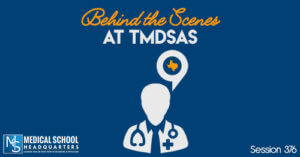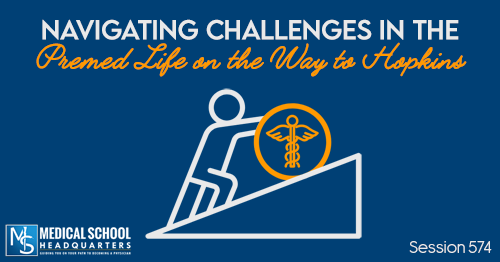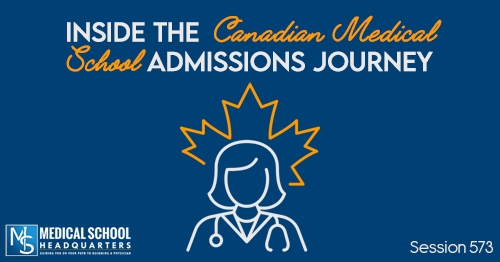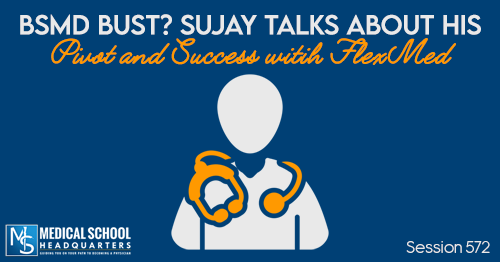Apple Podcasts | Google Podcasts

Session 376
Inside Health Education Podcast host, Enrique Jasso, Jr., discusses everything you need to know about the TMDSAS and applying to medical schools in Texas.
Enrique is the associate director of and podcast host at the Texas Health Education Service, the overarching organization that runs TMDSAS and JAMP (Joint Admission Medical Program).
Listen to this podcast episode with the player above, or keep reading for the highlights and takeaway points.
[02:56] Why TMDSAS Attended the UC Davis Conference
TMDSAS is very focused on Texas schools. Through their annual organization meeting with the Texas Association of Advisors for Health Professions, they provide updates for Texas advisors, but that information doesn’t necessarily reach out the state.
So when an out-of-state advisor has 300 applicants to an application service they’re not very familiar with, it’s incumbent on them to educate those advisors and educate those students on how to put their best foot forward in the team.
[04:00] The Percentage of Out-of-State Students Coming to Texas
Enrique thinks that the idea that students are applying to Texas because it’s cheap plays a factor. But it’s very much focused geographically to those areas that just might have a better recruitment system for Texas students.
The undergrad is basically recruiting high school students from Texas. They could go and study there for their undergrad career and then those students want to come back to Texas. And California makes sense just because there are so many students that are just looking to go anywhere.
As to the percentage of out-of-state students being accepted, it’s definitely one of the areas that they’re trying to improve through the Texas Health Education Service.
In fact, they get so many questions from out-of-state students as to how it looks to be competitive. So they’re definitely working on producing enhanced statistics focused on that understate population.
“I definitely suggest that applicants look into making a connection with Texas in some way, shape or form. You can't just come in and say, Hey, I want to come to Texas.”Click To TweetPotentially, out of the 10% of out-of-state students, a quarter of them went to their high school there.
[07:50] Why Texas Tuition Is So Cheap
The reason that Texas tuition is so cheap is because the state legislature actually provides for the tuition. So they are able to subsidize the overall tuition levels. So it’s Texas taxpayer money going into that. That’s where the requirement for Texas residency comes in.
“That's why the mission of so many schools is that people have a strong tie to Texas because it's so heavily subsidized by the legislature.”Click To TweetThat’s something that a lot of students don’t understand is that the in-state tuition versus out-of-state tuition for any medical school.The medical school isn’t making money off of the out-of-state student. The cost difference is due to the state being subsidizing for an instate student versus out-of-state student where money’s not coming from the state.
[09:50] Residency Positions in Texas
The mission of the TMDSAS is to provide the applications to the schools. But through this platform, the schools are in communication with each other. They speak before the Texas legislature and Senate to discuss those issues with residency positions in Texas.
“Every time they turn around and two new medical schools pop up, schools are talking about the issue that we don't need more medical schools, we need more medical residency.”Click To TweetAs more schools are coming up, it’s actually coming to the forefront of public opinion that residency positions are not catching up as quickly as medical schools are being built.
[11:17] Providing Resources for Students
Enrique explains that they want to enhance everything that the schools are already providing. A lot of medical schools have built into their mission that they want to reach out to students interested in promoting rural health.
For example, the Texas Tech University System is based in Lubbock, Texas, and has a lot of rural areas and communities. And so they’ve actually built a system around the Amarillo, Midland, Odessa area and Abilene area.
And so they are working together with different rural centers that can really enhance their mission that way.
They’re working with organizations in connecting the professional aspect backwards to the undergraduate experience and even a little bit further into the high school experience.
“What we do to step in is to inform students that these programs exist and amplify the messages that they're trying to provide so that they can enhance their programs.”Click To Tweet[12:29] Medical Students Staying in Texas to Practice
Information has been in place since 2003. Enrique reckons eight years’ worth of students who have now graduated from residency programs and are now practicing. They’ve teamed up with the Texas Medical Association to start getting better tracking of where students are being placed and where they’re practicing.
[13:07] What is JAMP?
JAMP (Joint Admission Medical Program) is a program that was created by the Texas legislature in 2001. They help economically disadvantaged students find a pathway to medical school.
“Everybody knows it's expensive to go to medical school and for economically disadvantaged students, that's a huge hurdle. JAMP was established to mitigate this issue.”Click To TweetFor instance, they have a five-week summer internship program where medical students actually go and live at the medical school. They’re taking classes at the medical school level. They’re shadowing doctors. They are participating in those communities and learning about the mission of the schools that they’re attending.
They additionally have a partnership with Kaplan to provide them full MCAT preparation.
If students remain in good standing in the program, they’re actually guaranteed a spot in medical school in Texas. And so they have their own mini match among JAMP students.
[14:28] Who Qualifies for JAMP?
First, you have to apply as a freshman or sophomore in college. Then you have a SAT or ACT score higher than the average for the state. Those averages are published every year on the JAMP website.
You have to have an estimated family contribution of eight or less on FAFSA application for a sophomore. And you have to have the support of your advisor at your university.
The beauty of JAMP is that they’ve built a similar partnership among university advisors so they have JAMP faculty directors. For each one of the 67 participating undergraduate institutions, there is a faculty director there who’s ready to help students with JAMP. Students would then meet with those advisors who are dedicated to helping the students and verifying that their journey is in the right direction.
“JAMP will accept about a hundred students a year in the entire state.”Click To TweetIt’s an extremely competitive program. But the students that the program is producing are actually performing just as well as an average student in the TMDSAS. It’s really showing that it fills the gap of students who are economically disadvantaged.
In two to three years, they’re able to come up to the level that a typical TMDSAS African would be at.
Enrique adds that you’d be amazed at how well these students are performing given the resources. They’re really shining with leveraging the opportunities that they have with shadowing doctors and going back to their communities to continue shadowing.
JAMP provides funds for public universities to have a dedicated person there. They’re also holding events like etiquette dinners for students. Through this program, students are able to form strong friendships and companionship.
“It's not just giving them a pathway to becoming a doctor. It's also showing them a lot of things that we might take for granted.”Click To Tweet[19:50] Setting a Good Example to Others
Enrique says they are always willing to collaborate and they would never hold something. Anytime they get requests or they can come by, taking a look at what the programs are, getting some more information on what’s worked for them and what’s not.
[21:49] What’s in Store for Texas Health Education Service?
It’s an organization still in its infancy, but obviously they’re continuing with the APPLY Magazine. The podcast is being rebranded from the TMDSAS podcast to Inside Health Education.
This is going to allow them to branch out beyond the TMDSAS and talk to other healthcare professionals and other professional schools. They can explore more of the academic and non-academic aspects of preparation.
They’re also bringing on board an advisor who’s recently retired. She’ll be coming on to help with developing more resources. They are starting accountability teams for undergraduate students. This is going to be a blueprint.
“You can get together a team of five people to get you started and making sure that everybody stays accountable.”Click To TweetThey provide the blueprint and everything that you need and the students just have to form the teams. A blueprint is some sort of syllabus where you’re at this point in the application process or in the preparation process.
Then they’re going to pair you up with other folks who are of similar age. Or if you’ve already found a group of folks already in that stage. Then they’re going to help you by creating that blueprint of where you need to get to.
This blueprint is for students but if an advisor wanted to implement that at their own school, it’ll be a resource that they can get from other education services. Additionally, they have another advisor who’s going to create a virtual advisor video series where she’s going to sit down and answer questions.
[26:18] Adding the Nontraditional Student Question
The TMDSAS added a question in their application asking the student if they’re a nontraditional student.
“We thought it would be more beneficial for a student to identify themselves as nontraditional because each journey is different.”Click To TweetThey also have a follow-up question about why they decided to be nontraditional. This gives them really great insights into a lot of students they might not have considered. There are spots in the application to discuss that with these questions, it allows an admissions committee member to say and decide to better pay attention to their essay.
Enrique thinks it’s definitely a part of the application that helps traditional students specifically. The second point was also for data gathering. They wanted to make sure that they wouldn’t get an inflated number of students who claim that they were nontraditional.
With this information they can share with other departments like the student affairs, they can develop support resources around that just as you would with LGBT data and AMCAS application.
From the feedback they received, they’re also expanding the gender options on the TMDSAS application for next year. All this being said, they’re really excited to promote inclusion and equity.
[28:59] Disadvantaged Essay
AMCAS has a disadvantaged essay and TMDSAS would usually defer a lot of that to the optional essay.
A lot of the Texas schools have already started developing their own secondary applications and they’re not $300 plus applications. They’ll ask specific questions that might connect better to their mission.
“There really isn't a school that is seeking a disadvantaged status necessarily.”Click To TweetMoreover, there are aspects of the application that they focus on. They provide socio-economic background information, but there really isn’t anybody looking for a disadvantage at this point.
With that being said, the deans get together twice a year to discuss the application and make sure that everything fits where they need it to look like.
[30:27] Application Mistakes
Enrique says that the most common confusion students have is with entering courses. They code their classes for TMDSAS as they code for other applications.
Particularly, they became more apparent when they started using BCPM GPAs. So what they do is assess the syllabus to make sure that it hits certain points that are required. They get this issue because they do the validation of the transcripts in-house.
The schools have made it very clear that if an applicant is not thorough in their application, they’re not somebody they want.
“It's so competitive to get into medical school. And there are applicants who went through proofread their essays and made sure that it wasn't a placeholder text.”Click To Tweet[37:12] The Optional Essay
Enrique says that it is not optional. Because it’s an opportunity for students to talk about anything in the application that wasn’t already asked to expand on the different sections.
For example, with activities, you only have 150 characters to talk about an activity. And if you want to make it a meaningful activity, you get an X amount of additional characters. Maybe that’s not enough to really say “this is what I want to become a doctor.” And maybe it’s not the main reason in one of the other sections.
The deans will sit down and go over the application and as he mentioned before, twice a year, they’ll decide whether or not they want to move forward with a section.
“With the optional essay section, there's an opportunity for you to speak directly to an admissions and commissions committee member.”Click To TweetIf you can’t tell your story and tell it in a concise way, you don’t have your elevator pitch ready, you’re not ready to apply.
[40:00] What Medical Schools Hope to See in an Application
It’s very clear that the core competencies are important to them, but also the mission that the schools are promoting and the value statements that they have. Enrique emphasizes the importance of including value statements because a lot of the schools in Texas will include values.
For example, TMDSAS has established values that they’ve had for a hundred plus years. And those values are important for them as employees of the TMDSAS and are important for students and as future alumni representing that. And so those are very important for those admissions committees to promote.
“Ultimately, it comes down to tell your story in a way that really connects with an admissions committee member looking for X, Y, and Z that promotes their mission statement.”Click To TweetUltimately, you are promoting yourself to become an ambassador for that school. And once you’re in, you’re no longer just a student because once you’re a doctor, you attended this medical school.
So it’s really important for students to put in the time to at least go to the school’s website. See which competencies show up in their mission statements and integrate them into their application as best as possible.
Moreover, in secondary essays, it doesn’t mean a full recreation of an essay. It’s just reframing what you’re already promoting within the context of what that school is looking for.
[43:20] How to Get More Information From TMDSAS
Visit the TMDSAS website, which they’re massively trying to refresh. They’re really making a strong effort to make sure that applicants get exactly what they need to know, including all the nuances of the application and figuring all that out.
TMDSAS is a website to get to and for students to clarify. If they’re three years out from applying, they can go to the site and open up an application and play around.
The Texas Health Education Service is focused on making the goal to becoming a doctor, a dentist, or a veterinarian. They seek to provide a clear pathway for students all the way from high school through the application. And they’re hoping to expand as well into those careers.
“It’s going to be a full gamut of everything that you need to do to prepare and back and engage with other professional organizations and get the resources that you need.”Click To TweetThey also have online communities that will be housed under the Texas Health Education Service.
The APPLY Magazine was created for them to be able to engage advisors for the health professions. They’re able to engage admissions officers and doctors as well.
It would be available in the spring. This year, they integrated some success stories from students so that they get to tell you what their journey has been like, what their experiences were like in professional school and leading up to it.
The magazine is available both on the TMDSAS website and the Texas Health Education Service website.
[47:11] Expansion of their Application Services to Other Profession Schools
“TMDSAS is the best application service of them all.”Click To TweetEnrique says he wouldn’t be surprised if the schools started switching over to TMDSAS. They’re actually in talks with some other health professional schools to expand beyond medical, dental and veterinary.
What’s really good about TMDSAS is they’ve really listened to both the schools and applicants.
For the schools, who have specific needs of aid in the application, they provide essential services for them. And for applicants, they want to make sure that they’re getting the best opportunity to tell our story and to be seen and heard in the application.
[48:54] The Medical School Match and Pre-Match
The Match pairs students to schools. Applicants go in and fill out which schools they prefer to match to. Then the schools will create a list of who they prefer to be added to their school.
And so the algorithm will pair students until the max number of spots are filled and the schools will each set those. And then that essentially gives applicants a match. The schools will set how many they want to match in the program.
In the pre-match, the schools are going to rank you high enough where they say, “if you rank us high enough, you’ll match to us.”
“A student who pre-match still goes through the regular match process.”Click To TweetIf you pre-match you still have to fill out a whole rank list and if the school that you ranked number one, you’re basically done.
The software says this student matched at his or her number one, they’re done. They’re out of the match process at that point. And then for students who haven’t matched that, their number one, they’re still in the process waiting for some movement, potentially.
If the student ranked a school higher than the school ranked them, the student just falls off of the list for that school. So that student is not available.
Moreover, a student can withdraw their application from a school. And even if they get a premed offer, they can reject the pre-match offer if they decided to go somewhere else.
The schools won’t know how they were ranked, but at least if the student’s available, it’s higher than wherever they’re at now. Because if it’s lower, they’ll fall off the list for that school. They will know if they’re only one above or number one. And also the student won’t know if they’re on the list.
They’ve actually moved up the pre-match offers the past year from mid-November to October 15th. It’s the same day the schools can reach out to out-of-state students.
This allows the schools to be able to start recruiting students that are highly desirable to their school. And so that match really does provide that equity among the schools. They don’t hyper load one school with top talent students. But it gives everybody an opportunity to match wherever they might end up.











